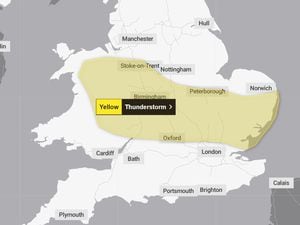As Shropshire Fire & Rescue Service's 75th anniversary year comes to a close we look back at major events in that time
Shropshire's fire service celebrated its diamond anniversary in 2023 with a series of open days at stations across the county.
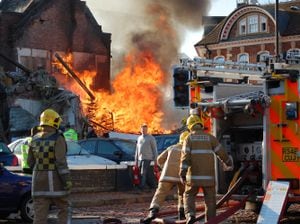
A part of the open day at Shropshire Fire & Rescue Service's headquarters in the county town included an eye-opening exhibition not only of the kind of kit they wore over the last 75 years but of the biggest and most dangerous incidents that they have attended over that time.
Many of them are well within living memory and include tragic hospital deaths, huge explosions, terrorism, and reports of what went wrong and how committees were looking to put things right.
Shrewsbury was the scene of one of the worst hospital fires in British history in February 26, 1968.
An almost unbelievable 24 patients were dead, killed by dense, suffocating smoke in their beds at Shelton Hospital.
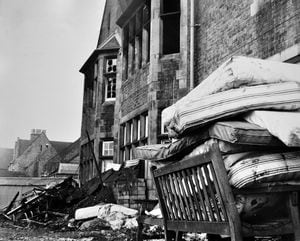
Most of them were in the locked Beech Ward, the hospital’s only locked ward. Choking smoke filled two wards of the women’s wing at the psychiatric hospital.
The tragedy led to a national outcry, changes to fire safety in major institutions and improved training for staff.
The fire led to calls for more modern mental hospitals and questions were asked in the House of Commons.
The spotlight on Shelton was intense. A public inquiry into conditions there in 1955 had presented a grim picture.
The official report published in December 1968 blamed officials from the Shrewsbury hospital management committee downwards for not giving night nurses training in fire procedure.
It said if the alarm had been raised only a few minutes earlier the blaze would have been much less deadly.
The cause was said to be “almost certainly” a cigarette end left in an easy chair, although the report thought it was perfectly sensible and reasonable for patients to be allowed to smoke on wards.
It was not Shropshire’s only major hospital fire. In January 1948 the Shropshire Orthopaedic Hospital was seriously damaged in a blaze, but all the patients were wheeled to safety by staff and helpers.
And in May 1975, nurses and staff similarly pushed and carried 26 women patients to safety in a fire at Shrewsbury’s Copthorne Hospital which caused damage put at £70,000.
Beech Ward at Shelton was to undergo a revamp in the mid-1980s which underlined the changes in thinking more generally about how to look after psychiatric patients.
In 1968 there had been 42 women patients in the ward. The change in mental health care and conditions since the 1960s had been dramatic and the reduction in numbers on the ward had been matched across the hospital.
The biggest change of all came on September 13, 2012, when the new Redwoods Centre opened nearby to replace Shelton. It took its first patients 10 days later.
As for the historic hospital buildings at Shelton, they have been redeveloped as part of a houses and apartments scheme called Leighton Park.
Perhaps the biggest night in the Shropshire fire service's history in terms of numbers of emergency crews was February 22, 1993.
There was a massive fire at a chemical works at Overley and simultaneously a petrol tanker spillage which threatened a devastating explosion in Shrewsbury.
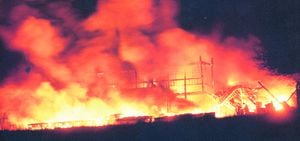
With thousands of litres of petrol cascading along the streets and into the drains the conditions were right to turn part of the county town into a huge bomb, all ready to detonate in one almighty fireball.
Shrewsbury rode its luck that night. There were heroes in the shape of firefighters who were sometimes working ankle deep in petrol, other emergency services, and volunteers, and it was thanks to them that Monday, February 22, 1993, is not remembered for all the wrong reasons.
Fumes hung heavy in the air in the county town and police said afterwards that if there had been a spark there could have been a massive blast demolishing several streets.
The drama that evening had begun at 6.40pm when a tanker delivering supplies to the Copthorne Service Station on Copthorne Road somehow overturned on the gradient and the tank containing around 7,000 litres of fuel ruptured.
The fuel gushed into surface water drains, sewers, and into the River Severn.
Police sealed off the Copthorne and Frankwell areas and later the Coleham district where the pumping station was also closed.
They frantically banged on doors to alert local residents and clear them from the area.
Firefighters sprayed the tanker with foam to try to lessen the risk of an explosion.
Residents who were evacuated went to stay with friends or family or went to an evacuation centre at the Music Hall, where they had hot drinks, with council staff mobilised to help them.
While this crisis was being dealt with, a major emergency developed in the eastern part of the county.
The alarm was raised at about 9.10pm by an elderly couple, Bill and Gwen Oakley, whose cottage bordered the Cox’s Chemicals plant near Wellington. Residents had long warned of the potential dangers from the site on their doorstep and were suddenly proved right when a fire broke out and engulfed the plant.
More than 70 firefighters, some wearing gas and chemical suits, battled to contain the blaze which ripped through the former military weapons testing centre.
Some 20,000 litres of chemicals, including pesticides and fertilisers, and four tons of mercury were involved in the fire.
People nearby were told to keep their windows shut, and in the aftermath local family doctors were alerted to be on standby to deal with any illnesses caused by the chemical cloud.
It turned out later that despite the night of double disaster, nobody notified members of Shropshire’s emergency planning team.
The first they knew about it was when they saw it on television.
They say lightning never strikes in the same place twice, but in 1988 it did, in one of Shropshire’s biggest ever fires.
That blaze of April 25 at COD Donnington was a virtual carbon copy of a fire which had caused over £150 million damage at the big military and civilian base in 1983.
A massive pall of smoke hundreds of feet high shrouded Telford and drifted away in the direction of Shrewsbury. Police broadcast an appeal warning people to avoid the area and not to go within a mile.
Two thirds of B1, a large storage building, and its contents was destroyed and the final bill was over £174 million. Just as in 1983, a large area was covered with asbestos fallout.
A board of inquiry concluded that the blaze must have been started deliberately, which means it was one of Britain’s most expensive incidents of arson in history.
Happily, as in the 1983 fire, there were no injuries. But taken together, the COD Donnington fires of the 1980s had cost the public purse well over £300 million in the space of just a few years.
Devastated by an IRA bomb attack, Shropshire Regimental Museum was to rise from the ashes.
With priceless and irreplaceable artefacts destroyed in the flames and smoke as the terrorists targeted Shrewsbury Castle, Salopians rallied round.
Some offered new items for display, others donated money.
And the upshot was that on Tuesday, May 2, 1995, three years after the bombing, the museum was reopened by Princess Alexandra as one of the county town’s top attractions.
The terror group’s aim was to start a number of major blazes in Shrewsbury simultaneously.
However at Staks at the Charles Darwin centre a sprinkler system contained the damage, and the bomb at Wades store in Shoplatch went off but caused little damage.
People who were in Shrewsbury on Sunday, January 3, will never forget the huge explosion that ripped a building apart near Welsh Bridge.
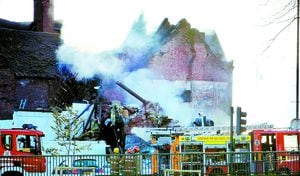
Disaster came just after 11.20am.
A building close to the Welsh Bridge comprising a shop and flats - next door to where the Wetherspoon pub is - simply disintegrated in a blinding flash and roar which shattered the calm of a tranquil Sunday morning.
Windows of some buildings hundreds of yards away were blown in or cracked.
The whole frontage of the stricken premises was thrown across the road in a pile of rubble and debris.
A young woman in the upper part of the building was blown out of it and landed in the street with serious injuries.
Eyewitnesses tell of a terrifying aftermath, with people close to the scene screaming and in tears.
A group of five people were in a car that was buried beneath the debris. It was a scene reminiscent, for those old enough to remember it, of the wartime Blitz.
The Shropshire Star reported that never has the centre of Shrewsbury seen an explosion of this devastating, destructive ferocity.
A year-long investigation by the Health and Safety Executive revealed no evidence of any breach of safety legislation.
The explosion at 1-5 Bridge Street resulted in five people suffering major injuries.
The lead HSE investigating Inspector Nicola Wade said: “This has been a complex investigation, involving many hours of work and forensic analysis to understand exactly what happened on January 3, 2010.
“The most likely cause of the explosion is that gas escaped from the fractured gas main and ignited nearby, despite no previous reports of a gas leak in the area.
“The gas main was correctly classified as low risk, it had been subject to stresses over time, causing a fracture.”

